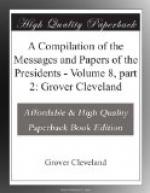Maricopa County is one of great extent. Its northern boundary is 95 miles long, its southern boundary 66, its eastern 45, and its western 102. This great area is to be taxed to construct a road which can, in the nature of things, be of advantage to but a fraction of it. There is no unity of interest or equality of advantage. It may very well be that a section of these lands along the line of the road, and especially town lots in Phoenix, would have an added value much greater than the increased burden imposed, but it is equally clear that much property in the county will receive no appreciable benefit.
The existing bonded indebtedness of Maricopa County is $272,000; the tax assessment of the county is about $5,000,000, and the population is estimated, by multiplying the vote cast in 1888 by 6, at about 12,000. It will be seen that the bonded debt, to say nothing of a floating debt, which is said to be small, is already largely in excess of the legal limit, and it is proposed to increase it by a subscription that will certainly involve $200,000, and possibly $250,000. If the bill becomes a law, the bonded indebtedness will very closely approximate 10 per cent of the assessed valuation of the property of the county.
The condition of things in the county of Yavapai, lying immediately north of Maricopa, and through which this road is also to run, though not directly affected by this legislation, is very instructive in this connection.
By an act of the legislature of Arizona passed the year before the act of Congress to which I have referred Yavapai County was authorized to subscribe $4,000 per mile to this line of road. The total length of the road in the county was 147 miles, and 74 miles, to Prescott, have been constructed. The secretary of the Territory, in response to an inquiry, states the debt of Yavapai County at $563,000 and the assessment for taxation at “between six and seven millions.” There are 73 miles of road yet to be built from the present terminus, Prescott, to the south line of the




